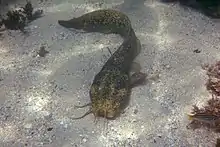Cnidoglanis macrocephalus
Cnidoglanis macrocephalus is a species of catfish (order Siluriformes) of the family Plotosidae, and is the only species of the genus Cnidoglanis.[1] It is commonly known as the cobbler, estuary cobbler, deteira, estuary catfish, South Australian catfish, or Swan River catfish.[2][3]
| Estuary cobbler | |
|---|---|
 | |
| Scientific classification | |
| Domain: | Eukaryota |
| Kingdom: | Animalia |
| Phylum: | Chordata |
| Class: | Actinopterygii |
| Order: | Siluriformes |
| Family: | Plotosidae |
| Genus: | Cnidoglanis Günther, 1864 |
| Species: | C. macrocephalus |
| Binomial name | |
| Cnidoglanis macrocephalus (Valenciennes, 1840) | |
| Synonyms | |
| |
Distribution
The cobbler is found from Main Beach, Queensland to Jervis Bay, New South Wales, and Kingston SE, South Australia to Houtman Abrolhos Islands, Western Australia and Duck River, Tasmania, in near-shore and reef habitats.[1]
Description
Like other eeltail catfish, the cobbler resembles a catfish in front, but an eel behind. It can grow up to 91.0 centimetres (35.6 in) SL, 2,500 grams (5.5 lb). They may live up to 13 years.[2] The dorsal and pectoral fins have sharp, venomous spines that can inflict painful wounds.[2]
Treatment
Treatment of injuries by submersion of the wound in hot water is suggested though the role of heat in denaturation of toxins is debated.[4]
However, despite this study, hot water immersion is still the recommended first aid treatment for envenomation. [5]
Ecology
The estuary cobbler is an inshore marine species which lives in shallow bays and sandy inlets near river mouths. It is found most frequently over sand, rocks, and weeds in the clear to turbid waters. By day, the estuary cobbler is most often found in holes and on ledges in banks.[2] Estuary cobblers stay in holes and under ledges during the day, then come out at night to feed. They are opportunistic feeders, primarily feed on molluscs (bivalves and gastropods), crustaceans (prawns and amphipods), polychaete worms, algae, and organic debris. Juveniles eat more crustaceans, often from among drifting macrophytic algae, while adults feed mainly on molluscs and polychaetes.[2] They are prey to birds such as cormorants and pelicans.[2]
References
- Ferraris, Carl J. Jr. (2007). "Checklist of catfishes, recent and fossil (Osteichthyes: Siluriformes), and catalogue of siluriform primary types" (PDF). Zootaxa. 1418: 1–628. doi:10.11646/zootaxa.1418.1.1. Retrieved 2009-06-23.
- Froese, Rainer; Pauly, Daniel (eds.) (2007). "Cnidoglanis macrocephalus" in FishBase. Aug 2007 version.
- "Estuary Cobbler". Fish.gov.au. Archived from the original on 2007-09-04. Retrieved 2007-08-01.
- Muirhead, David (2002). "Applying pain theory in fish spine envenomation". South Pacific Underwater Medicine Society Journal. 32 (3). Archived from the original on April 15, 2013. Retrieved 2011-10-30.
{{cite journal}}: CS1 maint: unfit URL (link) - Isbister, Geoffrey K. (2007). "Managing injuries by venomous sea creatures in Australia". Australian Prescriber. 30 (5): 117–121. doi:10.18773/austprescr.2007.073.
